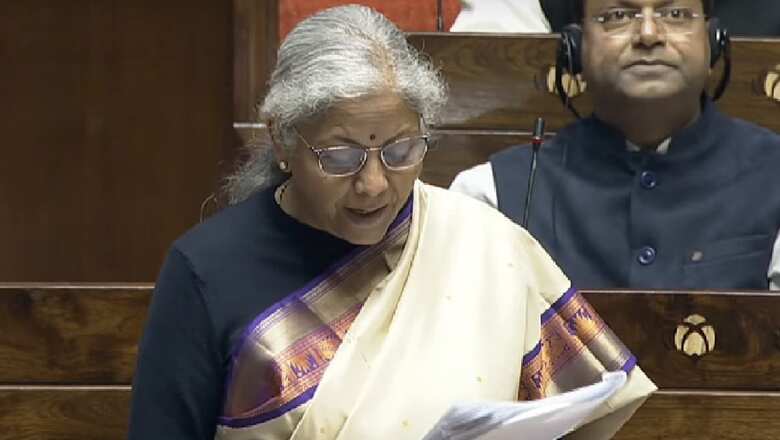
views
The “White Paper on the Indian Economy”, tabled by Union Finance Minister Nirmala Sitharaman in the Lok Sabha on February 8, 2024, outlines the inheritance of loss and the economic misadventures faced by India due to the policies of the previous UPA government. According to the document, the UPA’s tenure from 2004 to 2014 was characterised by economic mismanagement, financial indiscipline, and widespread corruption, which significantly hindered India’s growth prospects. The paper claims that these issues relegated India to one of the “fragile five” economies globally, creating hurdles that impeded economic activity and growth.
At the ET Global Business Summit, Prime Minister Narendra Modi delivered a stark critique of the decade preceding 2014, characterising it as a period that gravely endangered India’s economic stability. He also alluded to the White Paper on India’s economic conditions, which has since ignited widespread discussions. PM’s remarks were not just reflections but a scathing indictment of the previous administration’s governance, which, according to him, was marked by egregious financial mismanagement, riddled with scams, and paralysed by indecisive policymaking. This eroded investor confidence but also brought the nation perilously close to a precipice of distrust and despair.
There are four areas in which the current administration has worked to deal with the fiscal misadventures between 2004-14. First one of this is the practice of “phone banking” was identified as a contributing factor to the Non-Performing Assets (NPA) crisis in India during the NPA era. This term refers to the alleged influence exerted by politicians over banking decisions, where it is claimed that phone calls from influential figures could sway lending decisions of public sector banks. This led to the approval of loans for certain businesses without proper due diligence, contributing to the accumulation of NPAs within the banking system.
Under the NDA government led by PM Atal Bihari Vajpayee, the Gross NPA ratio in public sector banks was reduced from 16.0% to 7.8%, but during the UPA era, it escalated to 12.3% by 2013, partly due to political meddling in bank lending decisions. The crisis deepened by 2014 with the banking sector grappling with a substantial increase in bad loans, much of which were not recognized in official accounts. A Credit Suisse report from March 2014 highlighted that top companies with poor interest coverage ratios contributed significantly to the unrecognised NPAs, suggesting a systemic underestimation of the banking sector’s distress during this period. This period saw a massive escalation in gross advances by public sector banks from Rs 6.6 lakh crore in 2004 to R 39.0 lakh crore by 2012, with a large portion of loans turning problematic, particularly those originated between 2006 and 2008, as noted by a former RBI Governor in a 2018 parliamentary panel response.
The Modi government addressed the NPA crisis through a strategic approach termed the ‘4R’ strategy, encompassing recognition, resolution, recapitalization, and reforms. This strategy led to a significant reduction in bad loans, with public sector banks (PSBs) witnessing a decline of Rs 89,189 crore in their gross non-performing assets (GNPAs) during the financial year 2018-19. The efforts were part of a comprehensive plan to clean up the banking system, which included the implementation of the Insolvency and Bankruptcy Code (IBC) and the Securitisation and Reconstruction of Financial Assets and Enforcement of Security Interest (SARFAESI) Act, among other measures.
Second, the UPA government’s handling of the economy, particularly in response to the 2008 Global Financial Crisis, has been widely criticized for its mismanagement of public finances. The fiscal stimulus package introduced to mitigate the crisis’s effects was considered disproportionate, given that the Indian economy was relatively unscathed compared to other nations. Despite India’s quick recovery post-crisis, with GDP growth rebounding to 7.9% in FY10 from a low of 3.1% in FY09, the stimulus measures were extended beyond necessity, leading to unnecessary fiscal strain. This misjudgment was acknowledged by the then Finance Minister, indicating an awareness of the disproportionate response to the crisis.
Further exacerbating the situation, the fiscal discipline under the UPA regime deteriorated, with the Gross Fiscal Deficit (GFD) to GDP ratio remaining alarmingly high for six consecutive years, peaking at times beyond 6%. This fiscal indiscipline was compounded by off-budget borrowings and subsidies, which were not transparently accounted for, thus understating the actual fiscal and revenue deficits. Such practices led to a significant increase in government borrowing, which surged nearly 9.7 times in eight years, straining the economy further. This period of fiscal mismanagement culminated in a scenario where the government had to borrow 27% more than the budgeted estimates in 2011-12, indicating a deep fiscal malaise that posed a severe challenge to the economy’s stability and growth prospects.
Upon assuming office, the NDA government was met with a daunting task of rejuvenating the faltering public finances, a legacy of the UPA regime. Recognising the critical state of fiscal affairs, the NDA administration embarked on a comprehensive overhaul of India’s tax and spending framework, instituting long-awaited reforms like the GST to unify the market and ensure a streamlined tax regime. This period also saw the government navigating through the Covid-19 pandemic with prudent fiscal measures, ensuring that the necessary support was extended without compromising the health of public finances. Transparency was a key focus, with previously off-budget liabilities being integrated into the official accounts, marking a departure from past practices and ensuring a more accurate representation of the fiscal situation.
The NDA government’s approach to managing government borrowings marked a stark contrast to that of the UPA’s, with a focus on sustainability and prudence. Despite the increased expenditure necessitated by the pandemic, the growth in net market borrowings was kept in check, reflecting a disciplined fiscal strategy. The emphasis was also shifted towards enhancing the quality of public expenditure, with significant increases in capital expenditure aimed at spurring investment and rejuvenating the economy. This shift not only addressed the immediate needs arising from the pandemic but also laid the groundwork for sustainable economic growth, ensuring that public finances were directed towards productive uses that would yield long-term benefits for the country.
Third, the focus of the UPA government on heavy borrowing for unproductive expenditures, while neglecting infrastructure development, represents a significant misallocation of resources that has had long-term detrimental effects on India’s growth potential. During 2004-2014, capital expenditure, crucial for public investment in infrastructure, was de-prioritised, halving from 31% in FY04 to 16% in FY14 of total expenditure (excluding interest payments). This shift not only constrained the supply side of the economy but, coupled with excessive deficits boosting aggregate demand, led to higher inflation, a ballooning current account deficit, and an overvalued currency. The culmination of these policies was starkly evident in 2013, when the Indian rupee faced a severe crisis, underscoring the fallout from the government’s short-term populist measures over strategic infrastructure investment.
Moreover, the neglect of infrastructure and the logistical challenges it presented severely hampered industrial and economic growth. The UPA’s own admission in a Supreme Court affidavit, revealing a stark contrast in national highway development between the NDA and UPA tenures, underscores this point. The long-term consequences of such policy misadventures extend beyond mere economic metrics, affecting the nation’s global competitiveness, investment attractiveness, and overall quality of life. The misplaced priorities of the UPA government, focusing on short-term gains at the expense of crucial long-term investments in infrastructure, represent a grave injustice to India’s developmental aspirations, compromising not only the present but also future generations’ prospects for sustainable growth and prosperity.
Under the NDA government, there has been a marked improvement in the quality of public expenditure, with a strategic focus on infrastructure and asset creation, which are known to have a higher multiplier effect on the economy. The increase in capital expenditure, which has quintupled from FY14 to FY24 (RE), has not only avoided overheating the economy but has also elevated the share of capital expenditure in total expenditure from an average of 12% during the UPA years to approximately 14.5% under the NDA, reaching an average of 15.8% in the past five years. This pivot towards capital expenditure has effectively reversed the deterioration in expenditure quality seen before 2014, ensuring that revenue expenditure is now more strategically allocated towards fulfilling the welfare needs of the populace. Enhanced targeting through technological interventions has made this expenditure more efficient, enabling the implementation of extensive welfare programmes like the world’s largest free food programme and other direct benefit transfers to vulnerable sections of society, thus ensuring a balanced and inclusive economic growth model.
Finally, the UPA government inherited an economy poised for growth and reform, yet its tenure lacked any substantive economic reforms. Despite the promising economic indicators in 2004, including an 8% growth rate and a resilient economic outlook as noted in the Economic Survey of 2003-04, the UPA’s policies failed to capitalise on this momentum. UPA government’s approach was characterized by a reliance on the inertia of previous reforms and favorable global conditions rather than proactive policy-making to sustain and enhance growth. The period of rapid growth between 2004 and 2008 is attributed to the lag effect of earlier reforms and a booming global economy, rather than any significant policy initiatives by the UPA administration.
Post-2008, in the aftermath of the global financial crisis, the UPA’s strategies to maintain high economic growth are said to have compromised macroeconomic stability, leading to high inflation and fiscal deficits. The government didn’t leverage the years of high growth to solidify the budget and invest in future growth. This period saw average annual inflation rates reach double digits between FY10 and FY14, significantly impacting the cost of living for the average citizen. The lack of significant economic, social, and administrative reforms during this golden period of growth was a missed opportunity to strengthen India’s long-term economic foundations.
Conversely, the current administration prioritized transparent governance and engaged citizens in policy formulation, diverging from previous reliance on inefficient policies. Through a series of reforms, including digitalization, infrastructure enhancement, and ease of doing business initiatives, the government aimed to rejuvenate the economy and lay a foundation for sustainable growth. The establishment of an Expenditure Reform Commission highlighted a commitment to fiscal efficiency, optimising the use of taxpayer funds for national development. These efforts led to improved macroeconomic stability, recognized by international bodies like the IMF, and restored investor confidence both domestically and internationally. This comprehensive approach marked a significant shift towards dynamic governance, revitalising India’s economic prospects and instilling a renewed sense of optimism and potential for future growth.
The release of the “White Paper on the Indian Economy” by Finance Minister Sitharaman has been a significant step towards clarifying India’s economic trajectory during the UPA era and addressing prevalent misconceptions. This document illuminates the challenges and missteps of the past and underscores the current administration’s proactive, reform-oriented approach. By systematically dissecting the fiscal policies and their outcomes during the UPA tenure, the White Paper provides a factual basis for understanding the economic conditions that the NDA government inherited. This effort is commendable as it brings transparency and accountability to governance and educates the public on the complexities of economic management, setting a precedent for future administrations to follow.
Aditya Sinha is OSD, Research, Economic Advisory Council to the Prime Minister. Views Personal. Views expressed in the above piece are personal and solely that of the author. They do not necessarily reflect News18’s views.


















Comments
0 comment